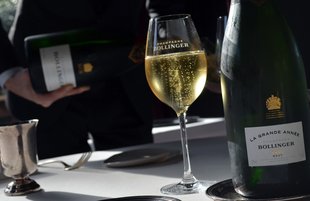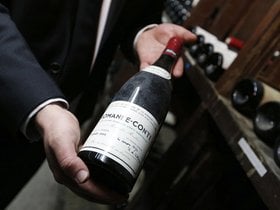Bollinger Champagne - Winemaking, Styles, Best Wines (2025)
Is Bollinger Champagne the perfect wine for you - for drinking and for investing?
You’ve probably seen it as James Bond’s “official” Champagne and heard its name whispered excitedly at events!
This is the magnificent sparkling wine made by Bollinger, an independent Champagne House that maintains over 150 hectares of vineyards. What’s so special about Bollinger Champagne?
What styles of wine does this Champagne House produce?
Are Bollinger Cuvees good for long-term investing?
Don’t worry - you don’t need the skills of James Bond to find out!
Let's dive into its history, wine styles, taste, and the best bottles to buy in 2024. We’ll also look at Bollinger’s investment potential and the smartest way to invest in this Champagne.
Further reading
- Want to get into the world of wine investment? Learn from the pros - take a look at our Insightful Guide To Wine Investing.
- Explore other Luxurious Champagne Brands like Moet and Armand de Brignac.
A Brief Intro To The House Of Bollinger

Founded in 1829 as Renaudin-Bollinger & Cie, Bollinger House is one of the most famous Champagne Houses in the world. It is located in Aÿ in Champagne, Northern France.
Generations of the Bollinger family have run this Champagne House, and it is loved globally for its extraordinary Pinot Noir dominant cuvees. The Bollinger style (or house style) Champagnes use Pinot Meunier and Chardonnay only to enhance the flavor of the cuvee.
The House produces several world-class cuvees, including the vintage Vieilles Vignes Francaises, R.D, and Grande Annee, and a non-vintage Special Cuvee. Apart from these sparkling wines, they produce a vintage red wine - Coteaux Champenois La Côte aux Enfants.
You will find the bulk of Bollinger vines on Grand Cru and Premier Cru plots.
A Quick History Of Bollinger

Athanase de Villermont, a French soldier, saw the exceptional potential of wines in Champagne. Together with Joseph Bollinger and Paul Renaudin, they founded the firm Renaudin-Bollinger & Cie.
Joseph Bollinger came to France around the same time as Charles Heidsieck and Johann-Josef Krug, and they all produced magnificent wines.
In 1920, Jacques Bollinger, grandson of Joseph, took over the house at 24. He led the house (with help from his cousins) through the recession and the Second World War.
After he passed away in 1941, Jacques’s wife, Elizabeth Bollinger (Lily Bollinger), had to pick up where her husband left off.
Madame Bollinger was known as a dauntless businesswoman, a perfectionist, and was the driving force behind the innovative Bollinger R.D. (recently disgorged) cuvee. (More about this in a bit.)
In the following years, family members took over the house, kept up with the trends and the founders’ quality standards.
In 2008, the custom was overturned, and Jérôme Philipon, a non-family member, took over Bollinger from Ghislain de Montgolfier.
Read more: Are you looking for something fun to do with your sparkling wine? Mix up a tangy Mimosa or grab our Favorite Sangria Recipe.
So, how did Bollinger come to be associated with the Bond movies?
The James Bond Connection

Ian Fleming first mentioned Bollinger Champagne in his fourth spy novel “Diamonds are forever” in 1956. However, movie lovers had to wait till 1973 to see James Bond sip Bollinger Champagne in “Live and Let Die.”
What makes Bollinger so unique that it is this Spy’s go-to drink?
Jérôme Philippon (former president of Bollinger) says that Bollinger is Bond’s drink of choice because it is “the most British of all Champagnes.”
Another explanation is that during the 1970s, then Bollinger chairman, Christian Bizot, was good friends with Bond producer - Albert Broccoli. Broccoli chose Bollinger as the hero’s favorite Champagne as a token of their friendship.
Let’s take a quick peek into the viticulture and winemaking process at Bollinger House.
The Bollinger Vineyards
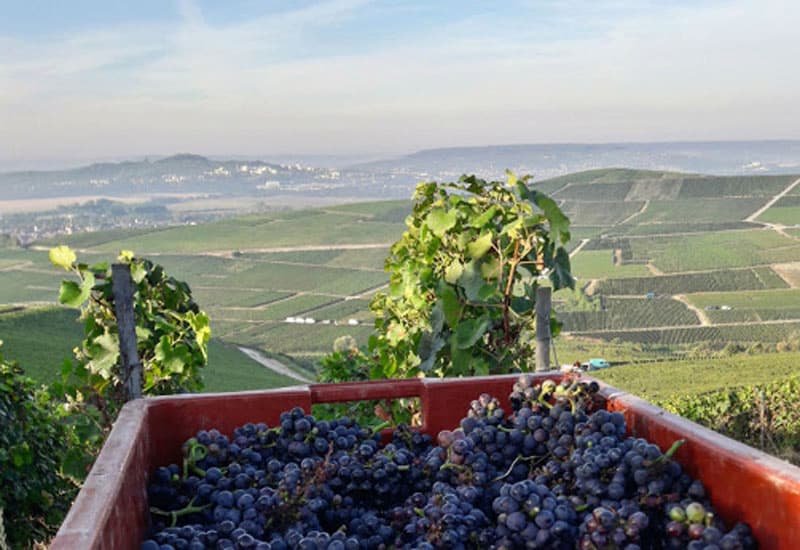
Bollinger is one of the very few Champagne Houses to produce most of the grapes for their blends. 60% of the grapes used come from their vineyards.
The Bollinger vines are some of the most tightly planted ones and form some of the most recognizable landscapes in the region.
Complex and powerful, the Pinot Noir grape represents 60% of the vineyards and gives the Special Cuvee its remarkable structure.
Pinot Noir is planted across Aÿ, Avenay, Tauxières, and Louvois et Verzenay. Chardonnay is planted in Cuis, and Pinot Meunier in Champvoisy.
The vines are all tended by hand and are reproduced using a process called provignage (a form of layering.) This preserves the heritage of the vine and produces the very exclusive Vieilles Vignes Francaises cuvee.
Also read: Find outWhich Champagne Glass would be best to serve your Fun Champagne Cocktail in! And while you are at it, grab our Classy Kir Royale Recipe too!
Bollinger’s Unique Winemaking Process
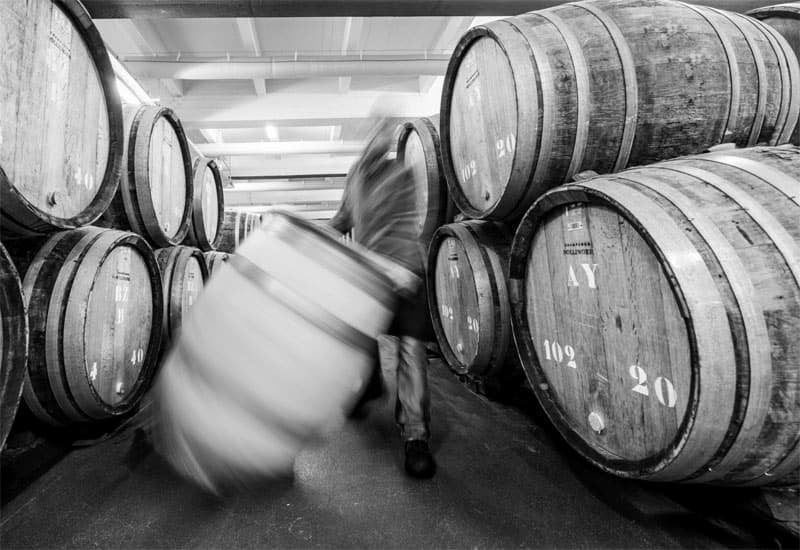
The Bollinger House’s cellars, and bottling process, are the best representation of how important time is for a wine’s quality.
After primary fermentation in stainless steel, wooden casks, or an oak barrel, the wine is bottled and sent to rest in the chalk cellars.
This long period in the dark develops the wines’ exceptional aroma and the smooth texture of the bubbles.
The pursuit of excellence does not stop at the winemaking process. The traditional methods of riddling (regular twisting bottles back and forth to keep sparkling wine sediment-free) and disgorging (eliminating sediment) are still carried out by hand!
Bollinger also allows their bottles to rest for up to three months after disgorgement to stabilize the wines.
Suggested Reading: Want to find the right bottle of red wine to pair with dinner? Try a Zesty Zinfandel or a Marvellous Malbec wine.
5 Amazing Facts About Bollinger Champagne
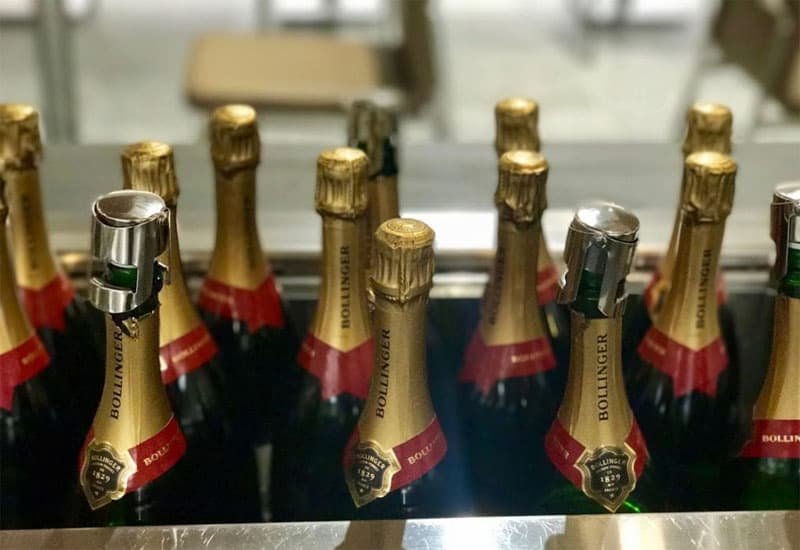
- Lily Bolinger didn’t want to produce Rose Champagne as it was most commonly associated with brothels in the 1960s. It wasn’t until 2007 that Bollinger released its first Rose Champagne.
- Queen Victoria issued a Royal Warrant to Bollinger in 1884. This helped the Champagne brand stand out.
- Bollinger has oak barrels dating back to 1903, purchased at three years old and maintained until 30 years old by their resident cooper.
- The last resident cooper in the Champagne region works at the Bollinger House.
- Bollinger uses sustainable winegrowing practices and was the first Champagne House to obtain a High Environmental Value certification.
Read more: Can't get that Bottle Of Chianti in time for your anniversary? We have 25 Fabulous Wine Gift Ideas for you to look at!
The Different Types of Bollinger Wines
Bollinger House has innovatively developed some fantastic sparkling wines and vintage red wine.
A. Special Cuvee
This iconic nonvintage cuvee is the Bollinger house style. The Special Cuvee is a blend of grapes from a given year, along with reserve wines. The blend of a Special Cuvee is 10% reserve wines, 60% Pinot Noir, 25% Chardonnay, and 15% Pinot Meunier.
Special Cuvee is aged in less for up to five years before release.
This cuvee has ripe fruit and spicy aromas, with hints of apple compote, roasted apples, and stone fruit. On the palate, there is a pleasing acidity and flavors of brioche, fresh walnut, pinpoint mousse, pear, and creme brulee.
B. Grande Annee
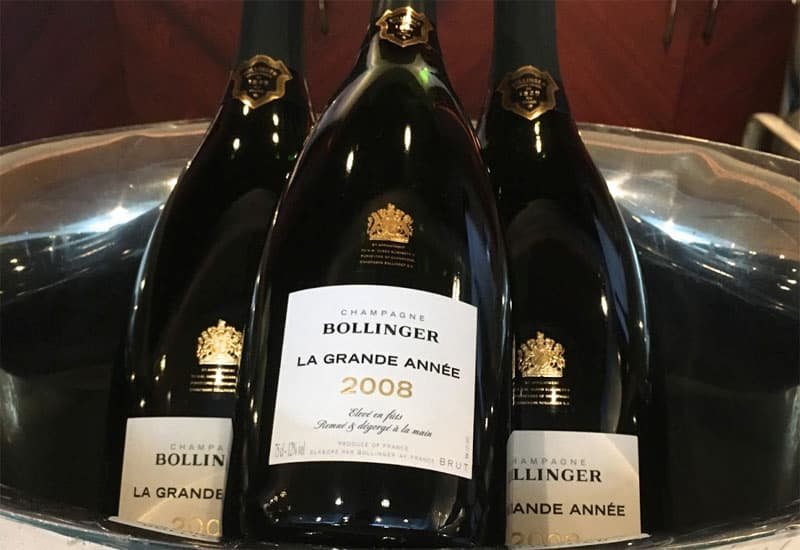
This vintage Champagne is a blend of 65% Pinot Noir and 35% Chardonnay. It is also available as a Rose and spends five years on its lees, and is aged with a cork stopper instead of a crown seal.
Grande Annee Cuvee is only produced when the harvest reaches absolute perfection. These wines have aromas of brandied fruit and toasted bread, and toasty notes of rhubarb and exotic spices.
C. R.D.
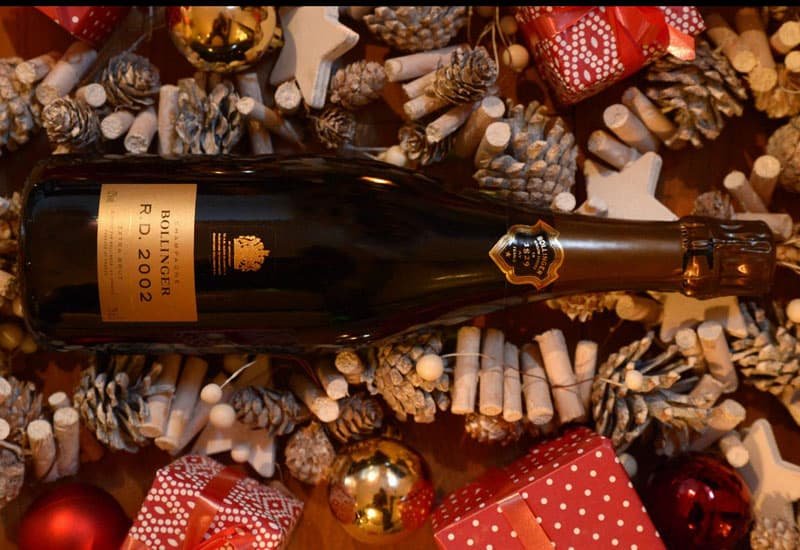
R.D. is a registered trademark of the Bollinger house and stands for Récemment Dégorgé (Recently Disgorged.) This vintage Champagne is aged for at least eight years on its lees.
Bond’s favorite Champagne has aromas of cocoa, ripe fruit, ripe apples, and nutmeg. It has a well-balanced and powerful palate and mineral finish.
D. Vieille Vignes Française

Small quantities of this cuvee are produced from two small plots, Chaudes Terres and Clos St-Jacques. These low-density vineyards are severely pruned and make 35% less juice per vine, creating this super-rich wine.
It has intense characteristics of very mature vintages, with a round, creamy mouthfeel and a touch of saline laced oyster shell on the finish.
E. Coteaux Champenois La Côte aux Enfants

This vintage red wine comes from the grapes grown in the Echelle vineyard.
A bottle of La Côte aux Enfants offers a velvety texture and a subtle balance. Sommeliers recommend that you pour this red wine into a decanter before serving.
F. Reserve Wine
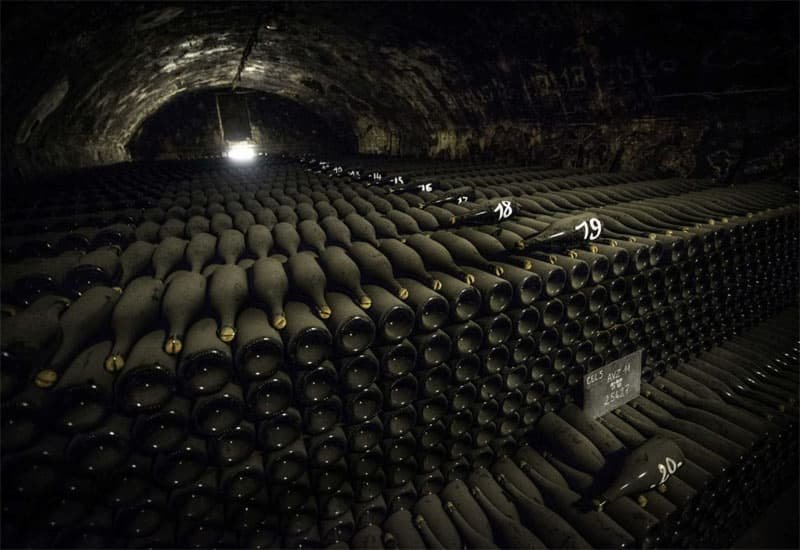
Bollinger saves some wines from the Premier Crus and Grand Crus every harvest.
These wines are bottled in magnums with cork and aged for five to fifteen years. There are around 650,000 magnum bottles stored in Bollinger’s cellar.
These reserve wines are used for blending Special Cuvee and other wines.
Now that your taste buds are screaming for a taste of this elegant wine look at these great Bollinger Champagnes you should buy!
8 Bollinger Champagnes You Have To Try!
Every bottle produced by Bollinger is a treat - here are eight of our favorites:
1. 1998 Bollinger R.D. Extra Brut
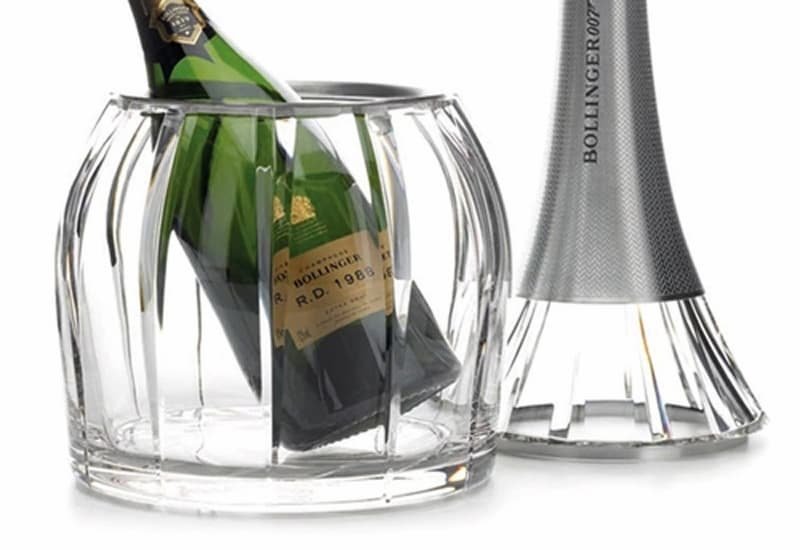
This Champagne is the classic dinner table bubbly! It has divine notes of butterscotch and toasty nuttiness on the nose. It has a brisk texture, a sour acidity and a concentrated and firm structure.
Price of 1998 Bollinger R.D. Extra Brut: $3527
2. 2007 Bollinger La Grande Annee Brut 'James Bond 007' Edition
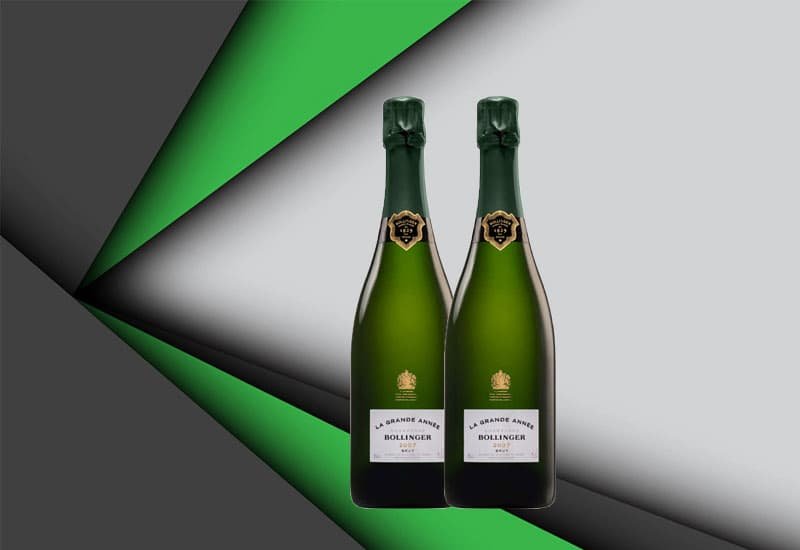
This elegant Champagne was released to celebrate the 40-year partnership with the Bond franchise. Made with 100% Pinot Noir, this Cuvee has an elegant and fresh bouquet of fresh fruit and pastry. Its moderately firm palate shows some delicate iodine notes.
Price of 2007 Bollinger La Grande Annee Brut 'James Bond 007' Edition: $2682
3. 1998 Bollinger R.D. Extra Brut 'Spectre' James Bond 007 Edition
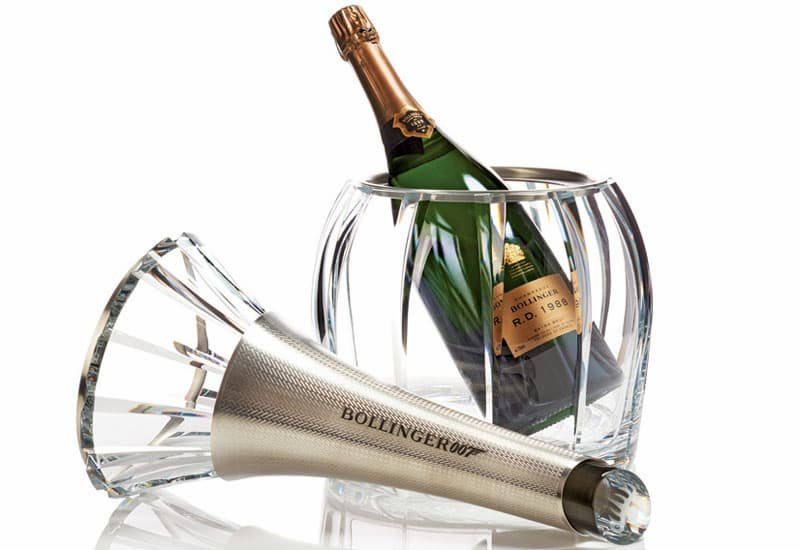
This Bond Champagne is composed of 68% Pinot Noir and 32% Chardonnay. It has a refined complexity that reflects the Grand Crus’ terroirs, and you will enjoy aromas of orchard blossom, hints of vanilla, crisp yellow orchard fruit, hazelnut, and stewed pear.
Price of 1998 Bollinger R.D. Extra Brut 'Spectre' James Bond 007 Edition: $2649
4. 2004 Bollinger Vieilles Vignes Francaises Blanc de Noirs
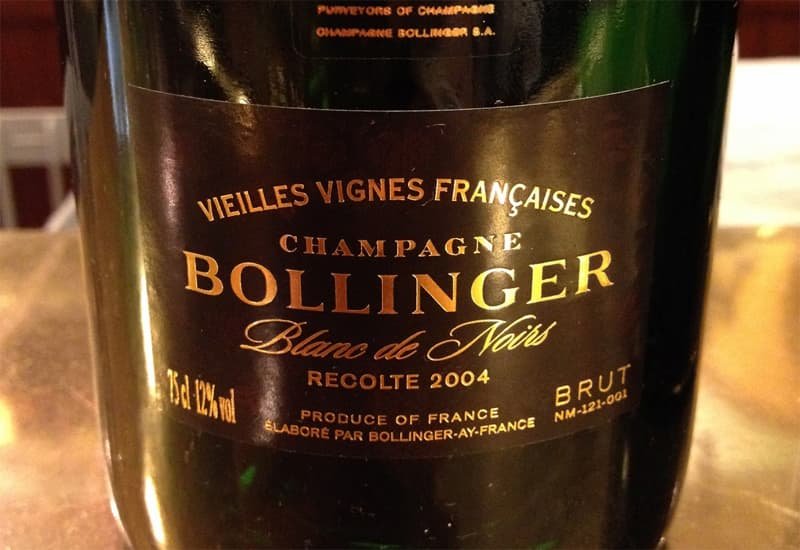
The Vieilles Vignes Francaises Blanc de Noirs is stunning to look at and taste! With the color of a bright autumn morning, it has mature, intense characteristics of older vintages. On the nose, you’ll enjoy aromas of candied fruits, dried apricots, honey, and quince.
Price of 2004 Bollinger Vieilles Vignes Francaises Blanc de Noirs: $2085
5. 1952 Bollinger 'Renaudin Bollinger' Extra Quality Very Dry - Brut
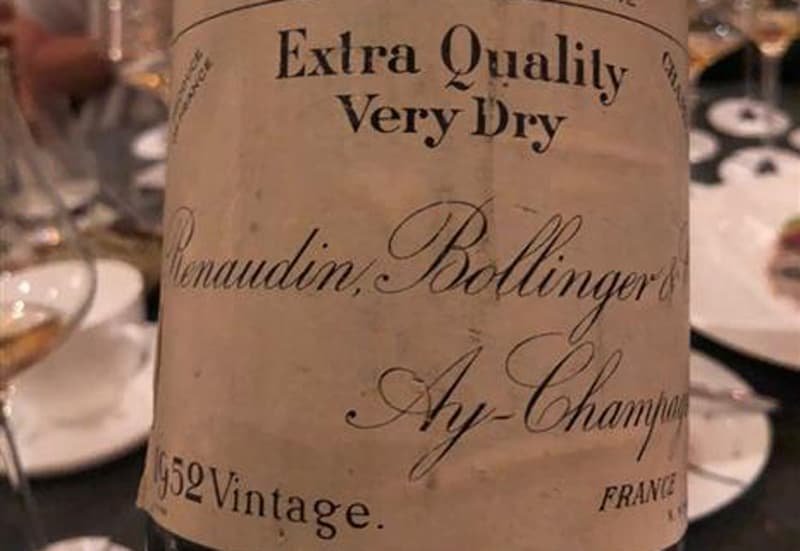
The Bollinger Brut Special Cuvee Champagne has a vibrant caramel bouquet and notes of spice and cumin that comes with its bottle age. It is a bit tart on the palate, well balanced and has a gentle finish.
Price of 1952 Bollinger 'Renaudin Bollinger' Extra Quality Very Dry - Brut: $1500
6. 2002 Bollinger Vieilles Vignes Francaises Blanc de Noirs

This divine vintage has deep musky aromas of cherry pit, buttered toasts, lemon curd, blood orange, and yellow rose. It has firm orange peel and red berry flavors backed by exotic notes of smoky lees, candied flowers, and clear honey.
Price of 2002 Bollinger Vieilles Vignes Francaises Blanc de Noirs: $1406
7. 2018 Bollinger La Grande Annee Rose
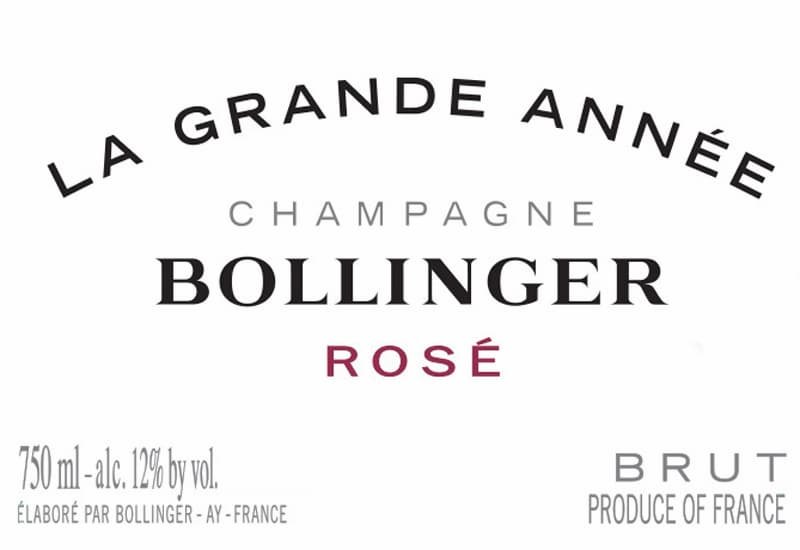
This fine rose is derived from the La Côte aux Enfants Pinot Noir. It has lovely aromas of black fruits and notes of citrus. It has a delicate palate, ripe acids, and a racy finish that prolongs the fresh and creamy texture.
Price of 2018 Bollinger La Grande Annee Rose: $221
8. 2012 Bollinger La Grande Annee Brut

This delicate wine is a reflection of Bollinger’s winemaking methods. It has a delightful bouquet of Marcona almond, apricot, and hazelnut backed by honey notes. It has an exceptional texture and structure, which develops into a fine, silky long finish.
Price of 2012 Bollinger La Grande Annee Brut: $159
Should You Invest In Bollinger Champagne?
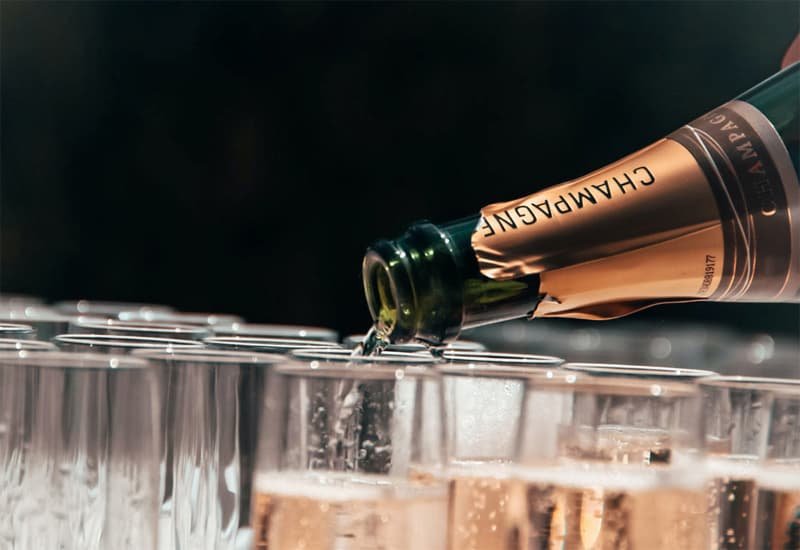
Rare, expensive Champagnes have always piqued the interest of wine collectors.
Leading from the front are the stunning wines from the Bollinger Champagne House - not only because it’s a recognizable Champagne brand and James Bond’s favorite glass of bubbles, but also because they uncovered old and rare wines in the basement of the house in 2010. In this fantastic find were 600 magnum bottles that pre-date the Second World War, with a few from 1830!
Do Bollinger wines age well?
Generally, most Champagnes should be enjoyed within a couple of years of buying them. When it comes to Bollinger Champagne, you could keep them safely stored for a bit longer:
- Vintage Champagne, such as Grande Annee and R.D Cuvee, can be kept for 10 years or more.
- Non-vintage Champagne, such as the Special Cuvee, can be stored for 4-5 years.
Bollinger has had a great track record at auctions. For example, at a Sotheby’s auction in 2016:
- A visit to the estate and a bottle of 1914 Bollinger Champagne was sold at $12,250.
- A Jeroboam of 1979 R.D. went for $6,738, and three bottles of 1973 Annee Rare were sold at $5,145.
Which Bollinger vintages should you invest in?
The 1999, 2002, 2004, and 2005 vintages earned high praise from critics. And when it comes to labels, Vieilles Vignes Francaises and La Grande Annee should be on your radar.
As with all wine investments, make sure you buy your Bollinger Special Cuvee and other wines from a trusted merchant to avoid paying unreasonable prices or buying counterfeit bottles!
That is why having a wine investment company like Vinoveston your side is so important. You get to have a team of Master Sommeliers and data scientists to help you along the way!
Invest In Fine Wines Effortlessly With Vinovest

Vinovest offers an AI-driven wine investment platform that helps you buy, authenticate, store, and sell your Bollinger Champagne or any other investment-grade wine!
They will even deliver your wine bottle to your home if you want to open it for a special occasion or to a buyer if you choose to sell it.
How It Works
1: Create your account with a name, email, and password. 2: Fill out the questionnaire to help the Vinovest experts determine your investing style. 3: Fund your account with a minimum of $1,000 is needed to get started. 4: Customize your portfolio! Vinovest’s algorithm will do the hard work and find the ideal wines for your investment style.
Benefits Of Investing In Wine Through Vinovest

Here’s are all the reasons why you should build a wine portfolio through Vinovest:
1. Best prices
Vinovest sources Barbera Wine, Pomerol Wine, and more from the top wineries, global wine merchants, and exchanges. What does this mean for you? You get to buy investment-grade wines at the best possible prices!
2. Easy buying, selling, and delivery
You can buy the best wines from the fantastic wineries with a few clicks - including Bollinger Special Cuvee and Laurent-Perrier Champagne. You can also choose to sell your wines at any time! If you choose to sell to a buyer in San Francisco or France or anywhere else in the globe, Vinovest will deliver the wine to them!
3. Optimal storage
Vinovest has a worldwide network of state-of-the-art storage facilities to keep your wine collection in perfect condition. These bonded warehouses have the ideal temperature, light, and humidity conditions.
4. Insurance coverage and security
Vinovest offers a full insurance policy that protects your wines against theft and breakage. Your wine collection is also under 24/7 surveillance, and there are power backups to make sure everything is kept safe and stored correctly.
5. Provenance and authenticity
You no longer have to worry about the authenticity of a bottle of Chateauneuf de Pape, Chateau Lafite, or any other wine. Vinovest will do all the background work and verify your purchase before the money leaves your account.
6. Curated portfolio
You can take advantage of Vinovest’s team of sommeliers and data scientists to help you build your portfolio of investment-grade wines.
7. Low overall costs
Wine investment done wrong can turn out very expensive! With Vinovest, you pay a low annual fee of 2.5% (1.9% for a portfolio over $50,000) for all the benefits that Vinovest offers.
8. Ownership
Even though Vinovest does the hard work, you have the bragging rights to all the wines you purchase. The bottles of Riesling, Sauvignon Blanc, and Rose Wine in your portfolio are yours!
A Slice Of Bollinger History in Your Collection
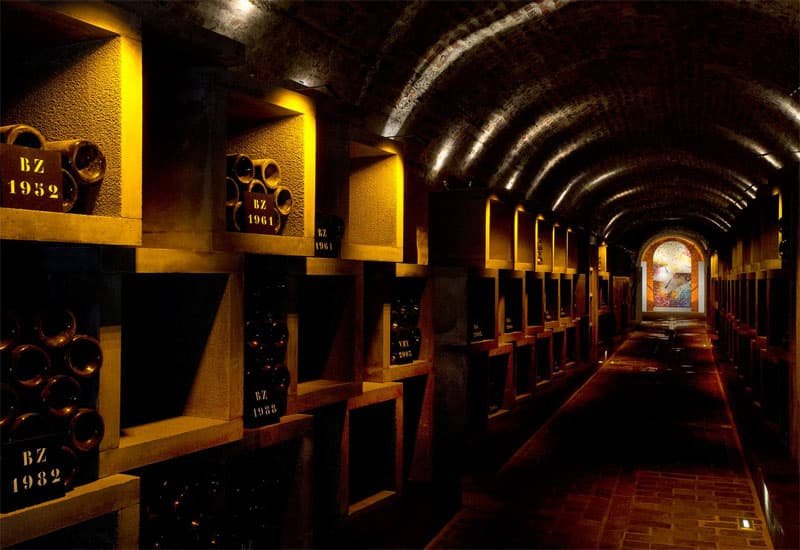
Bollinger Champagne is the perfect example of how tradition and innovation can work hand-in-hand to produce world-class wines consistently!
The cuvees produced at the Bollinger House are perfect for long-term investing and for adding that extra sparkle on special occasions!
And the best way to invest in them is through Vinovest’s intelligent platform.
So, sign up today and build a wine collection that would make every other wine enthusiast green with envy!
